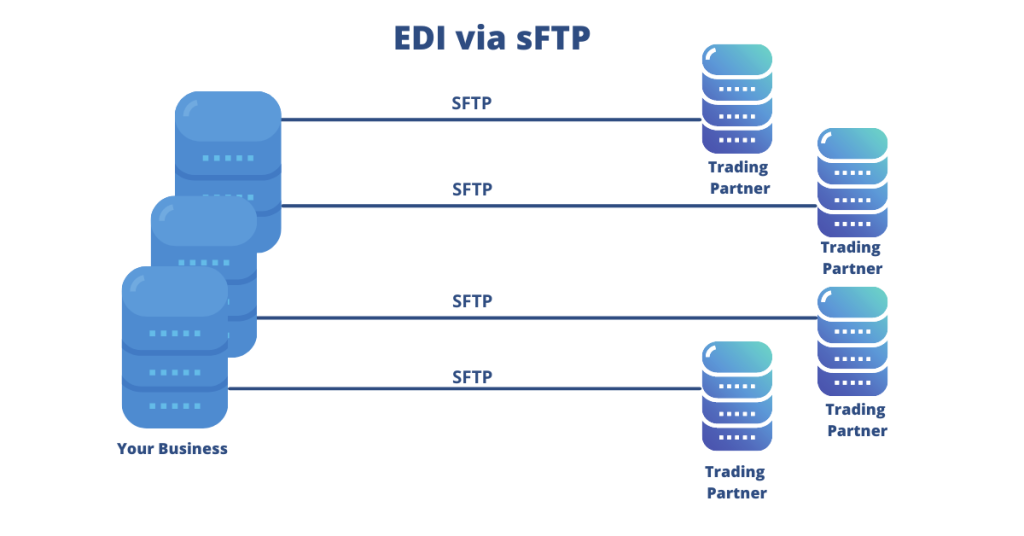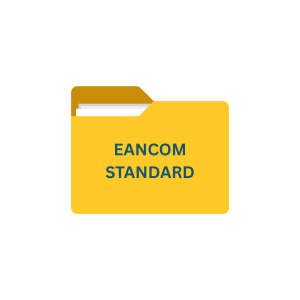Introduction
There are many ways you can securely exchange EDI data such as sFTP, AS2, and more. The one method that has been popular for Electronic Data Interchange (EDI) is sFTP (Secure File Transfer Protocol). Known for its enhanced security measures and straightforward usability, sFTP is a preferred protocol for many organizations looking to exchange EDI files efficiently.
Sending and receiving EDI files via sFTP offers a highly efficient and automated method of exchanging business documents, eliminating the need for manual processing and reducing the risk of errors. With this powerful system integration, companies can easily exchange data such as purchase orders, invoices, shipping notifications, and more in a standardized electronic format, regardless of the different systems or applications used by each trading partner.
Key Takeaways
- EDI via SFTP (Secure File Transfer Protocol) ensures secure, encrypted data exchange between businesses.
- It is a cost-effective offering of reliable and direct EDI file transfers.
- SFTP supports large file transfers, making it suitable for industries with high data volume requirements.
- The protocol enhances compliance by securing sensitive business information during transmission.
- EDI via SFTP is ideal for businesses seeking secure, scalable, and efficient data exchange solutions.
History of sFTP

The origins of sFTP can be traced back to the evolution of file transfer protocols, which began with FTP (File Transfer Protocol). Developed in the early 1970s, FTP allowed users to transfer files over a network. However, its lack of encryption posed significant security risks.
By the late 1990s, the demand for secure file transfers skyrocketed, leading to the development of sFTP, designed by the Internet Engineering Task Force (IETF) and built on the SSH (Secure Shell) protocol. sFTP not only addressed the security vulnerabilities of traditional FTP but also introduced robust encryption and authentication mechanisms. Over the years, sFTP has become the gold standard for secure file transfers, particularly in industries that handle sensitive data, such as finance, healthcare, and retail.
What is sFTP Protocol?

sFTP (Secure File Transfer Protocol) is a secure version of FTP, providing encrypted file transfer capabilities. It uses SSH to ensure that data, including EDI documents, is transmitted securely between trading partners.
Unlike traditional FTP, sFTP encrypts both the authentication credentials and the data being transferred, making it highly secure against potential cyber threats. This protocol is widely used for transmitting sensitive files like purchase orders, invoices, and shipment details in EDI systems.
When sending EDI files using the sFTP protocol, organizations can standardize their communication methods, allowing for secure and reliable data exchange. The standardized formats, such as ANSI X12 or EDIFACT, ensure that everyone involved in the exchange understands the data being shared.
Additionally, sFTP supports various file formats and can accommodate large file sizes, making it a versatile choice for EDI transactions. The ability to schedule transfers, track file statuses, and receive notifications further enhances its usability. For companies looking to optimize their data exchange processes, integrating sFTP with their EDI systems is a strategic move that bolsters efficiency and security. This combination ensures the timely delivery of essential documents and builds trust among trading partners, as each party can have confidence in the integrity of the information being exchanged.
What are the Key Attributes of the sFTP Protocol?
The sFTP protocol is characterized by several features that make it a robust choice for secure file transfers:
- End-to-end Encryption: Ensures all data is encrypted during transit, protecting it from interception.
- Authentication Mechanisms: Utilizes password-based or key-based authentication for secure access.
- Data Integrity Checks: Verifies that files are not altered during transmission.
- Platform Independence: Compatible with a variety of operating systems and devices.
- Reliable Error Handling: Detects and manages transfer interruptions or failures effectively.
These attributes make sFTP one of the preferred protocols for EDI file transfers, ensuring both security and reliability.
Common challenges in data exchange and how EDI via sFTP can address them
- One common issue is the lack of standardization in document formats, which can lead to miscommunication between trading partners. Different systems may use various formats for the same type of document, causing confusion and delays. Sending EDI files via sFTP addresses this challenge by providing a standardized method of exchanging information. By adhering to established formats, businesses can ensure that all parties interpret the data correctly, thereby minimizing the chances of errors and disputes.
- As businesses increasingly rely on digital communication, the threats posed by cyberattacks become more significant. Traditional methods of data transfer, such as email or unsecured file transfers, leave sensitive information exposed to interception. EDI via sFTP mitigates this risk by encrypting data during transmission, ensuring that only authorized individuals can access the information. This heightened level of security not only protects the business’s assets but also fosters trust between trading partners, facilitating smoother transactions.
- Furthermore, the manual handling of data exchange processes can be labor-intensive and error-prone. Many organizations still rely on outdated methods that require personnel to input data manually, leading to inefficiencies and increased operational costs. EDI via sFTP automates these processes, allowing businesses to streamline their operations and reduce the burden on their workforce. By eliminating manual tasks, companies can focus on more strategic initiatives, enhance productivity, and ultimately drive growth.
Who Uses EDI via sFTP Integration?

sFTP integration is widely adopted by industries that prioritize security and efficiency in their EDI processes. Key users include:
- Retailers: For exchanging purchase orders, invoices, and shipment notifications with suppliers.
- Healthcare Providers: To transfer patient records, billing information, and compliance reports securely.
- Manufacturers: For managing supply chain data like inventory updates and production schedules.
- Logistics Companies: To handle shipping documents, customs forms, and delivery updates.
These industries rely on sFTP for its ability to handle sensitive data while maintaining high levels of security and reliability.
How do I Send and Receive EDI via sFTP?

Integrating sFTP for EDI file transfers involves the following steps:
- Setup and Configuration
- Establish an sFTP server with proper SSH keys or password-based authentication.
- Configure the server to allow access to trading partners.
- File Preparation
- Convert business documents like purchase orders or invoices into EDI-compatible formats such as ANSI X12 or EDIFACT.
- File Transfer
- Upload the prepared EDI files to the designated sFTP directory.
- Notify the trading partner of the file availability.
- Data Retrieval
- Trading partners can download the files securely from the sFTP server.
- The files are then processed through the recipient’s EDI software for business use.
- Monitoring and Logging
- Maintain logs to track file transfers, ensuring accountability and compliance with regulatory requirements.
You can build and automate this complete process if you work with a third-party EDI provider like Commport Communications.
sFTP vs AS2 – The Key Differences
Attribute | sFTP | AS2 |
|---|---|---|
| Security | High encryption via SSH | High encryption with SSL/TLS |
| Authentication | Password or key-based | Digital certificates |
| Real-Time Capability | Limited | Supports real-time acknowledgments |
| Setup Complexity | Relatively simple | More complex due to certificate management |
| Use Cases | File transfer for static documents | Real-time EDI exchanges |
Benefits of Using sFTP Protocol
- sFTP offers numerous advantages for EDI integration:
- Enhanced Security
- Encryption ensures data confidentiality and protection against cyber threats. Single secure connection and encryption to protect data in transit. No need for client-side firewall access providing simplified firewall configuration.
- Ease of Use
- Straightforward setup and operation reduce the technical complexity of file transfers.
- Cost-Effective
- Requires minimal infrastructure, making it an affordable option for small to mid-sized businesses.
- Wide Compatibility
- Compatible with various EDI systems and trading partner platforms.
- Scalability
- Can handle increasing data volumes as business needs grow.
- Boost Speed and Enhance Business Process
- sFTP is much better than other file transfer protocols as it can easily support large file transfers and as well as bulk file transfers because of this it saves time compared to other modes of communication like email or cloud solutions.
8. Lowers the Risks During Data Exchange
Some of the communication protocols like FTP are very risky when exchanging documents as FTP connections can be easily compromised by using man-in-the-middle attacks. However, sFTP comes with shell security components, and it can protect the confidentiality and integrity of your data.
Disadvantages of Using sFTP Protocol
While sFTP is a robust protocol, it does have some limitations:
- Lack of Real-Time Communication
- Transfers are not instantaneous, which can delay time-sensitive exchanges.
- Manual Processes
- Often requires manual intervention for file uploads and downloads.
- Complex Error Handling
- Errors during transfers may require advanced troubleshooting skills.
- Limited Automation
- Without additional tools, sFTP does not inherently support automated workflows.
Why Choose Commport Communications as Your EDI Provider
Commport Communications is a leader in providing seamless B2B solutions such as EDI, VAN, GDSN, PIM, and business analytics, Here’s why Commport stands out:
- Comprehensive Solutions
- Offers a range of services tailored to meet unique business needs, from sFTP setups to end-to-end EDI management.
- Expertise and Support
- A dedicated team ensures smooth implementation, ongoing support, and troubleshooting.
- Scalability
- Commport EDI solutions grow with your business, ensuring sustained efficiency.
- Security First
- Implements robust encryption and compliance measures to protect sensitive data.
- Proven Track Record
- Trusted by over 6000+ businesses across industries for reliable and innovative EDI solutions.
Conclusion
sFTP is a powerful protocol for secure and efficient EDI integration. Its attributes, coupled with its ease of use, make it a popular choice for businesses looking to streamline their data exchanges. However, the complexities of implementation and management can pose challenges.
This is where Commport Communications excels, offering expert solutions that simplify sFTP integration while ensuring security, scalability, and compliance. By partnering with Commport, businesses can unlock the full potential of EDI via sFTP and achieve their operational goals with confidence.
Commport EDI Solutions
Need Help? Download: EDI Buyers Guide
Unlock the full potential of your supply chain with our comprehensive EDI Buyer's Guide — your first step towards seamless, efficient, and error-free transactions
Frequently Asked Questions
Commport offers affordable and scalable EDI solutions with robust security measures, and unparalleled support to ensure successful EDI integration.
sFTP excels in simple, secure file transfers, while AS2 is better for real-time EDI interactions with acknowledgments.
sFTP provides end-to-end encryption, authentication protocols, and data integrity checks to ensure secure file transfers.
sFTP is better suited for static file transfers and lacks real-time communication capabilities.
Yes, sFTP is widely used for EDI integration due to its encryption, reliability, and compatibility with various trading partner platforms.





